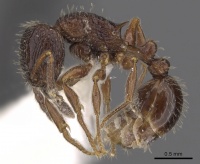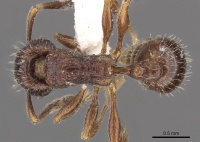Tetramorium plumosum
| Tetramorium plumosum | |
|---|---|

| |
| Scientific classification | |
| Kingdom: | Animalia |
| Phylum: | Arthropoda |
| Class: | Insecta |
| Order: | Hymenoptera |
| Family: | Formicidae |
| Subfamily: | Myrmicinae |
| Tribe: | Crematogastrini |
| Genus: | Tetramorium |
| Species: | T. plumosum |
| Binomial name | |
| Tetramorium plumosum Bolton, 1980 | |
Known from two collections, the non-type specimens were found in forest litter.
Identification
Bolton (1980) - The main diagnostic feature separating this species from other members of its group and also from most other species in the entire genus is the presence in T. plumosum of elongate plumose hairs. In Tetramorium generally, the presence of such bizarre pilosity is very rare, and in the Ethiopian region is only also known in Tetramorium pinnipilum and Tetramorium flabellum. The first of these belongs to the weitzeckeri-group and is separable by its 11-merous antennae, and the second belongs to the flabellum-group in which the sting appendage is dentate, not spatulate as in the members of the grassii-group. Within the group T. plumosum is closest related to Tetramorium regulare and Tetramorium grassii itself, but of course neither of these have plumose hairs.
Keys including this Species
- Key to Afrotropical Tetramorium species groups
- Key to Afrotropical Tetramorium ericae osiris inezulae gabonensis species groups
- Key to Afrotropical Tetramorium grassii species group
Distribution
Distribution based on Regional Taxon Lists
Afrotropical Region: Eswatini.
Distribution based on AntMaps
Distribution based on AntWeb specimens
Check data from AntWeb
Countries Occupied
| Number of countries occupied by this species based on AntWiki Regional Taxon Lists. In general, fewer countries occupied indicates a narrower range, while more countries indicates a more widespread species. |

|
Estimated Abundance
| Relative abundance based on number of AntMaps records per species (this species within the purple bar). Fewer records (to the left) indicates a less abundant/encountered species while more records (to the right) indicates more abundant/encountered species. |

|
Biology
Castes
Nomenclature
The following information is derived from Barry Bolton's Online Catalogue of the Ants of the World.
- plumosum. Tetramorium plumosum Bolton, 1980: 263, fig. 43 (w.) SWAZILAND.
Unless otherwise noted the text for the remainder of this section is reported from the publication that includes the original description.
Description
Worker
Holotype. TL 3.7, HL 0.84, HW 0.76, CI 90, SL 0.66, SI 87, PW 0.54, AL 0.94. Paratypes (5 measured): TL 3.6-3.8, HL 0.82-0.84, HW 0.73-0.78, CI 89-93, SL 0.64-0.68, SI 87-89, PW 0.50-0.55, AL 0.90-0.96. Ocular diameter 0.18-0.19, about 0.24-0.25 x HW.
Mandibles longitudinally striate. Anterior clypeal margin with a median impression. Frontal carinae sinuate, reaching back almost to the occiput, surmounted by a distinct ridge or flange to the level of the posterior margins of the eyes but posterior to this the flange quickly decreasing in height until no stronger than the remaining cephalic sculpture. Antennal scrobes broad but only shallow. Eyes of moderate size, maximum diameter 0.18, about 0.24 x HW. Occipital margin broadly and shallowly concave in full-face view. Propodeal spines elongate and narrow, the metapleural lobes low and broadly triangular. Petiole in profile with an elongate anterior peduncle, equipped beneath with a narrow sagittal crest. Node of petiole high and narrow in profile, the posterodorsal angle more broadly rounded than the anterodorsal. In dorsal view both petiole and postpetiole broader than long. Dorsum of head sculptured with sharply defined but irregular longitudinal rugulae, without cross-meshes except on the occiput where a few anastomoses (but no reticulum) are developed. 10-12 rugulae present between the frontal carinae at the level of the eyes and the spaces separating them are glossy, smooth or with only vestiges of faint superficial ground-sculpture. Dorsal alitrunk with irregular weak, disorientated rugulae which are widely spaced, and with scattered cross-meshes present. Spaces between rugulae smooth or very nearly so. Petiole, postpetiole and gaster unsculptured, shiny. All dorsal surfaces of head and body with numerous erect or suberect strong hairs, the apices of which are strongly and very distinctly plumose. Antennal scapes and tibiae only with short, fine, appressed pubescence. Colour uniform brown, the appendages lighter in shade than the body.
Type Material
Holotype worker, Swaziland: King’s Forest, 12.vii.1962 (R. Ghent) (Museum of Comparative Zoology). Paratypes. 5 workers with same data as holotype (MCZ; The Natural History Museum).
References
References based on Global Ant Biodiversity Informatics
- Bolton B. 1980. The ant tribe Tetramoriini (Hymenoptera: Formicidae). The genus Tetramorium Mayr in the Ethiopian zoogeographical region. Bulletin of the British Museum (Natural History). Entomology 40: 193-384.

